Good nutrition isn’t about following the rules.
The healthiest people we know aren’t cardboard cut-outs of perfection.
In fact, you might be surprised how they eat.
That’s because instead of following someone else’s diet advice, they’ve developed a personal food list based on their own dietary quirks.
You couldn’t predict their lists if you tried.
They take into account not just nutrition, but also their individual taste preferences and how foods make them feel.
This approach leaves room for ice cream and tortilla chips and gummy bears—and doesn’t require them to eat “healthy” foods they can’t stand (or aren’t able to tolerate).
And you know what? The method works really well.
It allows these folks to eat nutritiously, enjoy their meals, and feel “in control” around food—without feeling restricted or deprived.
The best part: Anyone can do this. (In fact, we’ve been successfully using it with our clients—over 100,000 people—for more than a decade.)
Introducing the traffic light eating method.
Before we continue: If seeing the name of this method makes you A) recoil in anger, B) roll your eyes, or C) look for the back button, hear us out.
Yes, it’s a little controversial. The reason: Some companies use a similarly-named approach to provide a set of food rules that apply to everyone.
This isn’t that.
Using our system, you’ll define your own “green light,” “yellow light,” and “red light” foods based on how they work for you. (And spoiler alert: “Red light” doesn’t mean bad.)
As you’ll see, nutrition-quality is an important element in choosing foods—but it’s not the only one. Your likes and dislikes, habits, goals, and physiology all play a role, too.
Let’s walk through it.
Green light foods = anytime, anywhere foods
These are foods you eat regularly and with ease. You can eat them normally, slowly, and in reasonable amounts.
Whole foods usually make up most of this list, but it may also include foods that you enjoy purely for pleasure, in amounts that work well for you.
Nutrient density isn’t the only criteria here: Your “green lights” are foods that you enjoy, align with your culture and lifestyle, and make your body and/or mind feel good.
And, while we encourage mindful eating, green light foods are ones you don’t have to think too much about. You just eat and enjoy them: simple as that.
Yellow light foods = “sometimes” / “maybe” / “small doses” foods
Your “yellow lights” are foods you might eat occasionally, with a degree of caution or mindfulness.
Maybe they trigger a bit of indigestion (but not a full-scale emergency trip to the restroom).
Perhaps you prefer to enjoy them in small, bite-sized doses. Or only on certain occasions, like out at a restaurant with friends.
It’s worth noting that yellow light foods don’t have to be “problem” foods.
They might be nutritious foods you incorporate into your diet, sometimes.
Maybe you’re “meh” about eggplant, but you’ll eat it when your partner cooks it, or it’s part of a restaurant dish.
Or you’ll eat tofu once a week on “meatless Mondays.”
Or you cook okra, but only on the weekends when you have time to make it just right.
We’d consider these yellow light foods.
As you can see, “yellows” can be any type of food. Alcohol and certain “junk foods” might wind up in this category, but heck, so could kale.
Red light foods = foods you typically avoid, minimize, or make less available
Red light foods aren’t bad. They’re just foods that you choose not to eat (at least most of the time).
Red light foods may not work for you because:
- They don’t help you achieve your goals
- You always overeat them
- You’re allergic to them
- You can’t easily digest them
- You just don’t like them
Ultra-processed foods often fall into this category since many folks find that, once they start eating them, they can’t stop. Some people even call them “trigger foods,” because after taking a single bite, they blink, and the couch is covered in Cheeto dust and empty ice cream cartons.
Again, this doesn’t mean you avoid these foods all the time.
For example, you might not want to keep the freezer stocked with cheesecake, but perhaps you’ll happily enjoy a generous slice on a special occasion.
At the same time, so-called “healthy” foods can wind up on the red light list too.
If broccoli makes you gag, put it on the red light list. (Because who wants to eat foods they hate?)
If apples cause you to break out in hives, that’s a red light.
If plain, baked chicken breast makes you feel like a deprived dieter, you guessed it—red light food.
Worth reiterating: Putting something on your red light list doesn’t mean you can never eat it again. In fact, unless you have severe allergies, it can be worth experimenting with now and then.
You might grow to love something you currently dislike. Or become better at eating it in moderation.
Hold up: Couldn’t the traffic light system promote shame, guilt, or disordered habits?
Our answer: It depends on how you use it.
The idea behind the PN traffic light system isn’t to label foods or follow a particular system “perfectly.”
The purpose, rather, is to build awareness about which foods work best for you, and which ones don’t. So you can make informed decisions for yourself.
But not all traffic light systems are created equal.
Some programs out there use the traffic light system too, but they use it differently than PN.
They use it based purely on their interpretation of nutritional value, to indicate which foods should make up the bulk of your diet (green), which foods you should eat in moderation (yellow), and which foods you should eat infrequently and in small portions (red). And the list is the exact same for everyone.
Our approach is different, for a couple of reasons:
First, we don’t want to suggest that certain foods are “bad” or off-limits.
The data we’ve seen (and our experience working with clients) tells us that restriction often leads to more problematic eating behaviors, not less.
And while we do offer tools to help people make more healthful choices, our big intention is to help clients make improvements and adjustments that feel right for them.
What’s more, when used as an awareness-building tool, we’ve found the traffic light eating method can actually help people move away from disordered habits, and experience a greater sense of self-efficacy, flexibility, and enjoyment with their food choices.
That can feel life-changing.
When you know which foods work well for you, which ones are “meh,” and which ones cause unwanted issues, food choices become easier.
Plus, you can adapt your traffic lights at any time. They evolve with you.
Better still, you make decisions based on YOU. Your body, your mind, your health. Not someone else’s diet, meal plan, points, or rules.
Your nutritional choices become less rigid and more flexible. Food becomes less stressful, not more.
A special note for coaches
If you’re a coach, we highly encourage you to start gathering information about your client’s food preferences right from the start.
In PN Coaching, we do this as part of our client intake. We learn from the beginning about our clients’ likes, dislikes, allergies, intolerances, and so on.
It’s important to know your client’s starting point before making any nutritional recommendations.
After all, there’d be no point in recommending meat to a vegetarian, or peanut butter to someone who’s allergic to nuts, or seafood to someone who lives in the desert, or something “soooo tasty” to someone who’s undergoing chemotherapy and can’t taste a darn thing.
Personal preferences aren’t the only factor to consider.
If you’re a nutrition coach, you’ll still want to teach your client which foods are most nutritious and will be most suitable for their goals.
Over time, your client may develop more appreciation for healthful foods.
If their diet currently contains a lot of highly-processed foods, they might not have many whole foods on their “green” list right now. But tastes can change. Many people find that as they start to eat more minimally-processed foods, they find them more palatable.
For example, if your client categorizes all vegetables as a “yuck / barf,” perhaps you can help find a vegetable or two that fits their yellow light (and maybe eventually green light) list.
Want some examples? Here’s what our traffic lights look like.
Again, there is no set traffic-light list for every person. While in general, whole foods such as vegetables, fruit, and lean proteins are a good idea, when it comes to specific foods, you might have a different list.
To help you better understand how that works, here are a few personal examples from folks at PN.
Let’s start with the authors of this article.
Brian St. Pierre, MS, RD, Director of Nutrition and Performance at PN
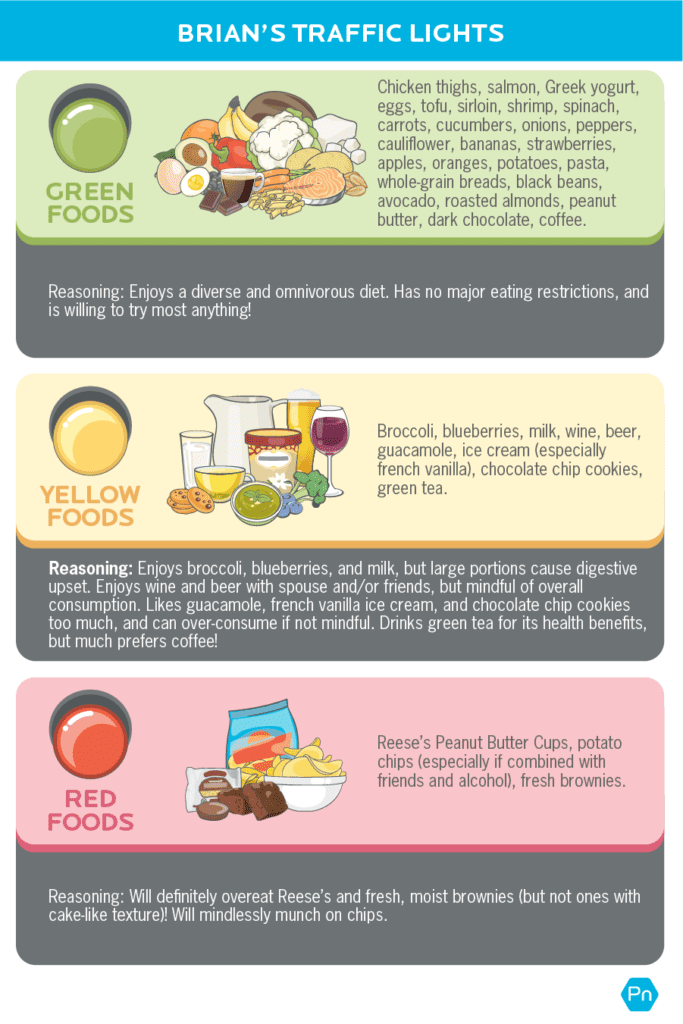
Camille DePutter, PN Coach and Adviser
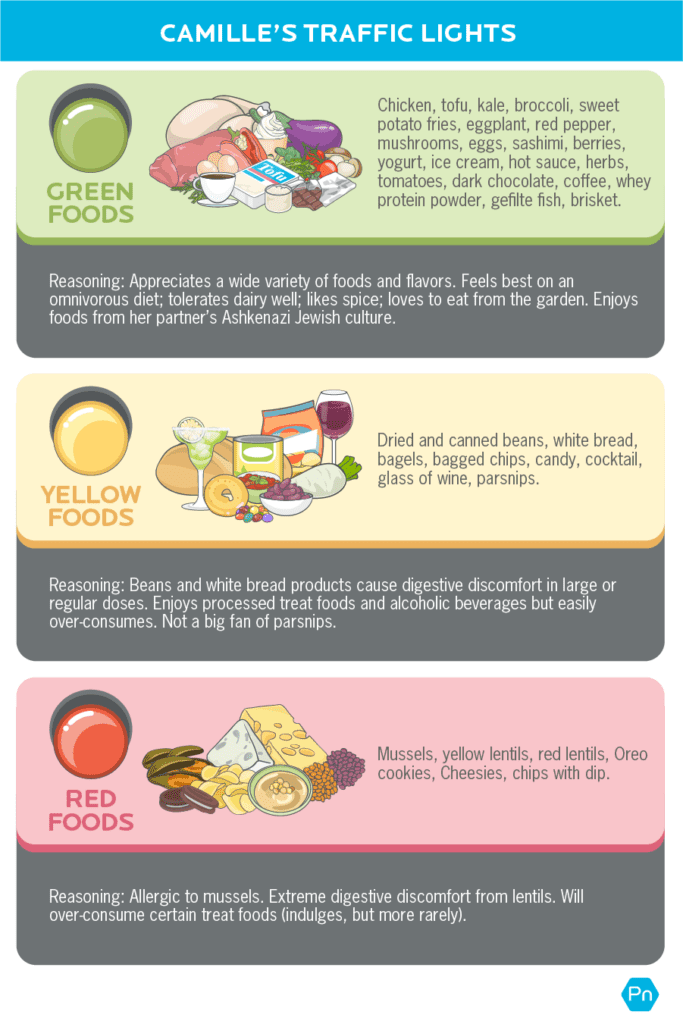
Now here’s a list from Krista Scott Dixon, PhD, Director of Curriculum at Precision Nutrition.
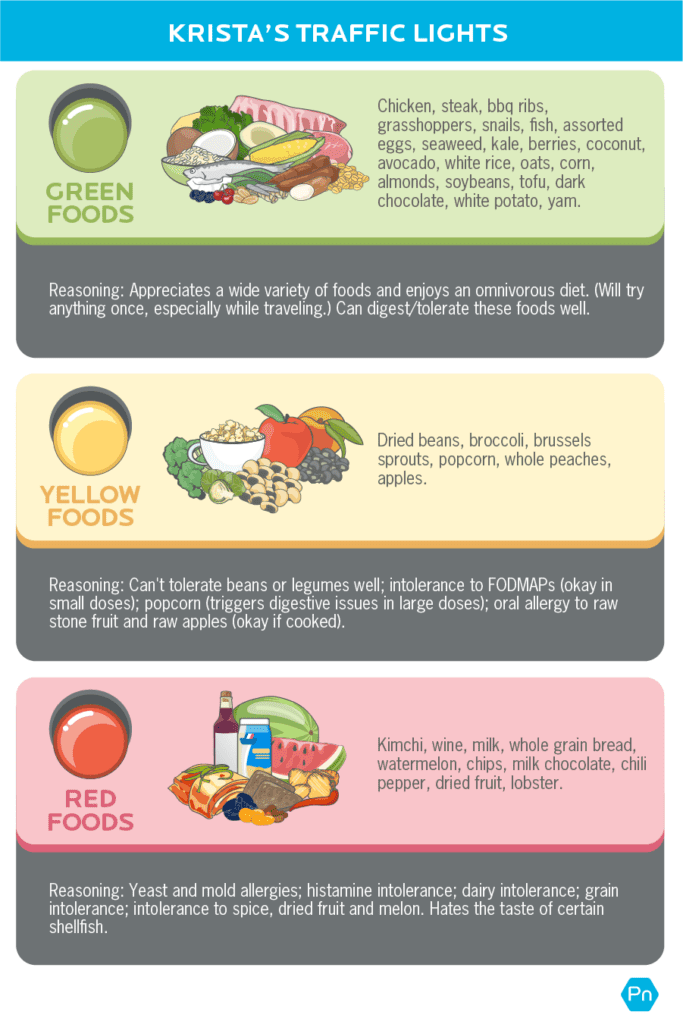
What about a scientist? Here’s the list of Helen Kollias, PhD, Science Advisor at Precision Nutrition.
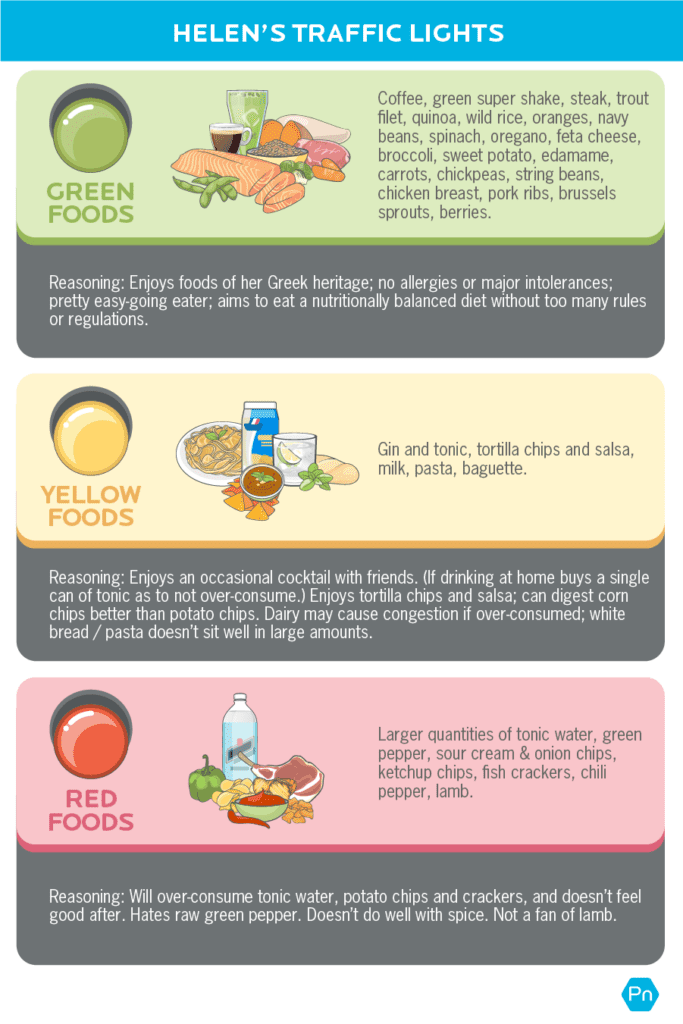
Want to build your own list—or help a client with theirs?
Start by using our Red-Yellow-Green Foods Worksheet.
To put your list into practice, here’s a tip: Keep mainly “green” foods handy and available. You’ll naturally eat more of them.
And, if you want to consume fewer foods on your “yellow” or “red” light list, you can make your life easier by simply not buying them. (That way you have to exercise less willpower when you get home.)
That said, you can also choose to eat foods that DON’T work for you. Unless you’re deathly allergic, eating from your “red light” list is always an option.
Either way, you’re in control, and you know what to expect. (Read: “If I go ahead and eat this red-light food, I might eat a whole lot of it versus choosing something from my green-light list. Right now, I’m okay with that.”)
When used as a way to get to know yourself better and make mindful choices, this system isn’t restrictive. It’s liberating.
For more insight into how this works, here’s a look at how PN co-founder Dr. John Berardi chooses his foods, from lemon water (“green light”) to red peppers (“red light”).
Your relationship to certain foods will change over time—and that’s a good thing.
The only constant in life, and human beings, is change.
Your tastes may change as you age. Your priorities may change, too. Sometimes new allergies and intolerances form. (And if you’re really lucky, some may go away.)
Don’t let your “traffic lights” define you or keep you stuck.
Instead, consider them an opportunity to get to know yourself better as you evolve and grow.
As Alice said while in Wonderland, “I knew who I was this morning, but I’ve changed a few times since then.”
We’re all a bit like Alice. Might as well enjoy the ride.
Are you ready to go from a skilled coach to an exceptional one? The PN Level 2 Master Health Coaching Certification is your opportunity to do just that.
This 20-week program is designed for coaches who are committed to mastering real-world coaching. It’s not just about knowledge—it’s about applying it to make a difference in your clients' lives.
This is NOT a "Level 2" nutrition course. It's NOT about meal plans or macros. It’s an advanced training program that prepares you to:
🔑 Understand your clients on a deeper level, beyond food and fitness, and help them make real, lasting changes.
🔑 Coach with confidence through complex situations like mental health, stress, and emotional setbacks.
🔑 Master behavior change so your clients stay committed—no matter what life throws their way.
It’s the only program of its kind that combines self-paced learning, weekly live mentorship, and real-world coaching practice.
Plus, Level 2 program is NBHWC-approved, meaning graduates are eligible to pursue board certification through the National Board for Health & Wellness Coaching (NBHWC) or professional membership with the Health Coaches Alliance (HCA).
That’s a big deal. These credentials open doors, expand career opportunities, and help you stand out in a growing field.


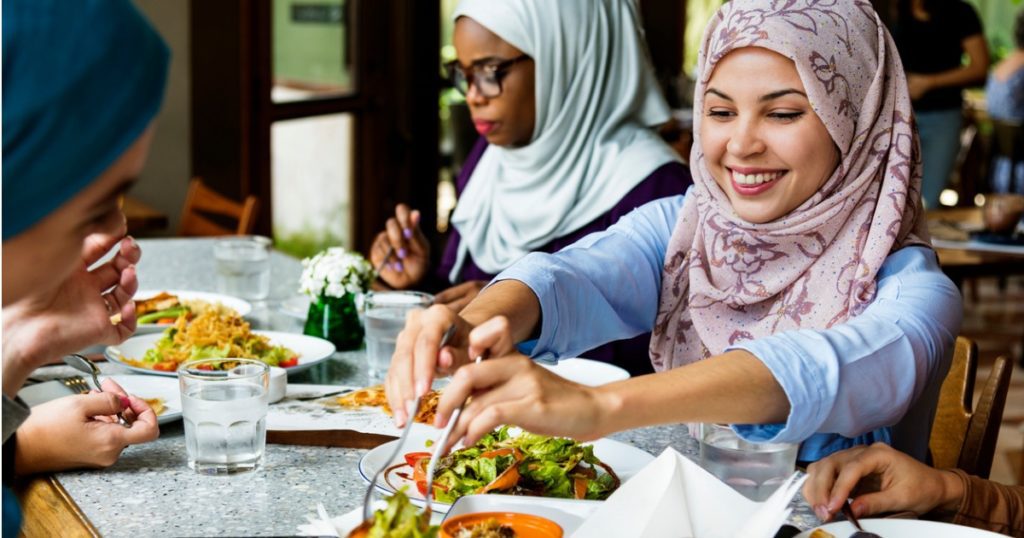
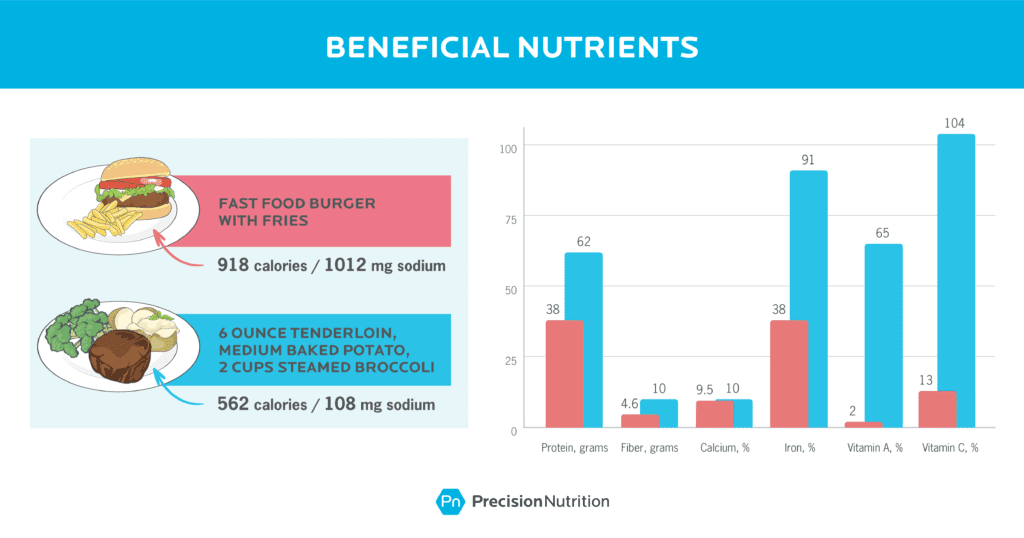
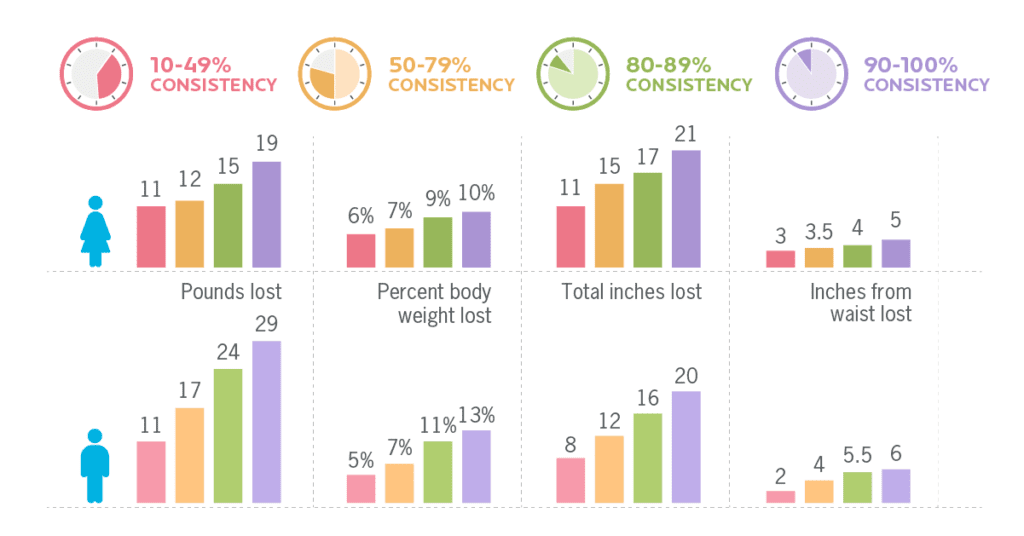
Share